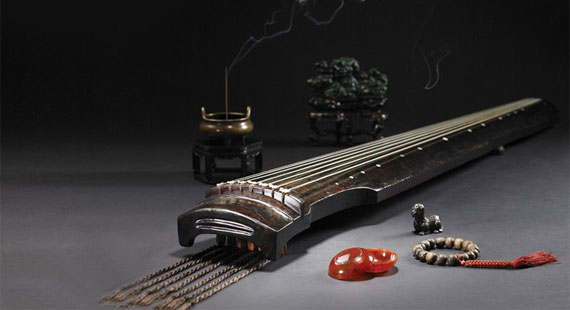
In the world of Chinese instruments, one character plays a larger role than all the rest.
Until the 1920s, the character ńÉ┤ (q├Łn) had a very specific meaning ŌĆō it was only used to refer to the ÕÅżńÉ┤ (gŪöq├Łn), an ancient Chinese instrument. Now however, ńÉ┤ can be used to refer to any musical instrument that has strings. Ironically, its leap in status to cover all musical instruments came about due to its "marriage" with a Western instrument ŌĆō distinctions arose when people needed to make clear they were referring to a different instrument: the ķÆóńÉ┤ (g─üngq├Łn), known to the rest of us as the piano.
The character ńÉ┤ was once written as shown in the left picture, as an almost exact side view of the instrument. The two vertical strokes resemble the strings, and the horizontal strokes resemble the capos and the curved stroke draws the outline of the resonance chamber. The current form ńÉ┤ is simply a pictophonetic character (ÕĮóÕŻ░ÕŁŚ x├Łngsh─ōng z├¼).
The character has plenty of, well, character, and as such there are many stories about it.
It is said that in the Spring and Autumn Period (771 to 476 BC), there was a famous performer, Bo Ya, who came across someone with an eerily talented ear, named Zhong Ziqi.
As Bo Ya thought about the lofty mountains, Zhong Ziqi was immediately able to tell what he was thinking about from the music. When Bo Ya was thinking about flowing water, Zhong Ziqi again read Bo Ya's thoughts. Whatever Bo Ya played, Zhong Ziqi was immediately able to read his mind. This earned him the reputation of being called a ń¤źķ¤│ (zh─½y─½n), someone who understands the music, hence a bosom friend. When Zhong Ziqi died, Bo Ya broke his instrument and was determined never to play it again, because he had lost his ń¤źķ¤│. And today we still have those two pieces of music ķ½śÕ▒▒ (G─üosh─ün), lofty mountains, and µĄüµ░┤ (Li├║shuŪÉ), flowing water.
Another popular piece of ÕÅżńÉ┤ music, ķģÆńŗé (JiŪöku├Īng), which literally means "drunken ecstacy," is said to have been composed by the rabble-rousing idealist RuŪÄn J├Ł, who was one of the Seven Sages of the Bamboo Grove in the Eastern Jin Dynasty. In addition for his famed poetry and outspokenness, he was also known far and wide as a drunk. As the story goes, on one occasion he drank so much he was "dead drunk" for sixty days in a row, which was actually part of a ploy to avoid being tied into a marriage with the royal family, which in his eyes evidently came with too many strings attached.
By putting ńÉ┤ and a similar musical instrument, ńæ¤ (s├©) together, along with the word for harmony (ÕÆīĶ░É h├® xi├®), the idiom ńÉ┤ńæ¤ÕÆīĶ░É is created, which literally means that the sound of both instruments are in concord, and thus also means marital harmony.
ńÉ┤ is a symbol of noble culture and there are idioms to reflect how it should be respected. One points out that eating a beautiful animal like a ķ╣ż (h├©) crane, or burning a beautiful instrument like the ńÉ┤, represents the destruction of beauty. Thus to ńģ« (zhŪö) stew the crane and ńäÜ (f├®n) burn the ńÉ┤, or ńģ«ķ╣żńäÜńÉ┤(zhŪö h├© f├®n q├Łn) means to utterly ruin something good.
Another idiom points out the futility of playing something beautiful for ears that simply can't appreciate it. If Õ»╣ (du├¼) to the ńēø (ni├║) cow you Õ╝╣ (t├Īn) play the ÕÅżńÉ┤, you have chosen a very poor audience - Õ»╣ńēøÕ╝╣ńÉ┤(du├¼ ni├║ t├Īn q├Łn).
As a general term, the ńÉ┤ can also be used to create many compound words. By combining it together with ķÆó (g─üng) steel, you get a piano(ķÆóńÉ┤) . If you combine it withÕÅŻ (kŪÆu) mouth , you get a harmonica(ÕÅŻńÉ┤). Combining it withńöĄÕŁÉ(di├ĀnzŪÉ) electronic , you get a electronic organ( ńöĄÕŁÉńÉ┤), and withÕ░Å (xiŪÄo) small and µÅÉ (t├Ł) lift up, you get violin (Õ░ŵÅÉńÉ┤) . By adding it to ń½¢ (sh├╣) vertical, you can create a harp(ń½¢ńÉ┤).
Image credit:Weng5ji.blog.com
Article by Wang Tong (ńÄŗÕĮż)


















































